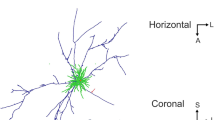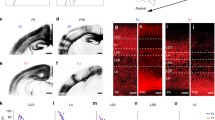Abstract
In the adult brain, cortical neurones that project to other cortical areas have traditionally been classified as either ‘associational’ (having connections within the ipsilateral hemisphere) or ‘callosal’ (projecting to areas in the contralateral hemisphere). Using double-labelling with fluorescent dyes1,2, we have now identified a novel category of mature cortical neurone that has both an ‘associational’ and a ‘callosal’ axon. Such neurones can direct their callosal axons either to a cytoarchitectonic area homotopic to the one in which their cell bodies reside or to an entirely different heterotopic region in the contralateral hemisphere. These cortical neurones with divergent axon collaterals in the adult neocortex differ from recently described neurones that have two axons only transiently during development3–5.
This is a preview of subscription content, access via your institution
Access options
Subscribe to this journal
Receive 51 print issues and online access
$199.00 per year
only $3.90 per issue
Buy this article
- Purchase on Springer Link
- Instant access to full article PDF
Prices may be subject to local taxes which are calculated during checkout
Similar content being viewed by others
References
Kuypers, H. G. J. M., Bentivoglio, M., Catsman-Berrevoets, C. E. & Bharos, A. T. Expl Brain Res. 40, 383–392 (1980).
Kuypers, H. G. J. M., Bentivoglio, M., Van Der Kooy, D. & Catsman-Berrevoets, C. E. Neurosci. Lett. 12, 1–7 (1979).
Innocenti, G. M. Science 212, 824–827 (1981).
Killackey, H. P. & Ivy, G. O. Neurosci. Abstr. 7, 178 (1981).
O'Leary, D. D. M., Stanfield, B. B. & Cowan, W. M. Devl Brain Res. 1, 607–617 (1981).
Goldman, P. S. & Nauta, W. J. H. Brain Res. 122, 393–413 (1977).
Goldman-Rakic, P. S. & Schwartz, M. L. Science 216, 755–757 (1982).
Chavis, D. A. & Pandya, D. N. Brain Res. 117, 369–386 (1976).
Jacobson, S. & Trojanowski, J. Q. Brain Res. 132, 209–233 (1977).
Hedreen, J. C. & Yin, T. C. T. J. comp. Neurol. 197, 605–621 (1981).
Baleydier, C. & Mauguiere, F. Brain 103, 525–554 (1980).
Jacobson, S. & Trojanowski, J. Q. Brain Res. 132, 235–246 (1977).
Jones, E. G. & Wise, S. P. J. comp. Neurol. 175, 391–438 (1977).
Mesulam, M. M., Van Hoesen, G. W., Pandya, D. N. & Geschwind, N. Brain Res. 136, 393–414 (1977).
Tigges, J. et al. J. comp. Neurol. 202, 539–560 (1981).
Goldman-Rakic, P. S. The Organization of Cerebral Cortex (eds Schmitt, F. O., Worden, F. G., Dennis, S. G. & Adelman, G.) 69–97 (MIT Press, Cambridge, 1981).
Sperry, R. W. Science 133, 1749–1759 (1961).
Gazzaniga, M. S. Scient. Am. 217, 24–29 (1967).
Author information
Authors and Affiliations
Rights and permissions
About this article
Cite this article
Schwartz, M., Goldman-Rakic, P. Single cortical neurones have axon collaterals to ipsilateral and contralateral cortex in fetal and adult primates. Nature 299, 154–155 (1982). https://doi.org/10.1038/299154a0
Received:
Accepted:
Issue Date:
DOI: https://doi.org/10.1038/299154a0
This article is cited by
-
Local and remote cellular responses following a surgical lesion in the Cebus apella cerebral cortex
Brain Structure and Function (2012)
-
Prominent periventricular fiber system related to ganglionic eminence and striatum in the human fetal cerebrum
Brain Structure and Function (2011)
-
Estimation of interhemispheric dynamics from simple unimanual reaction time to extrafoveal stimuli
Neuropsychology Review (1992)
Comments
By submitting a comment you agree to abide by our Terms and Community Guidelines. If you find something abusive or that does not comply with our terms or guidelines please flag it as inappropriate.



